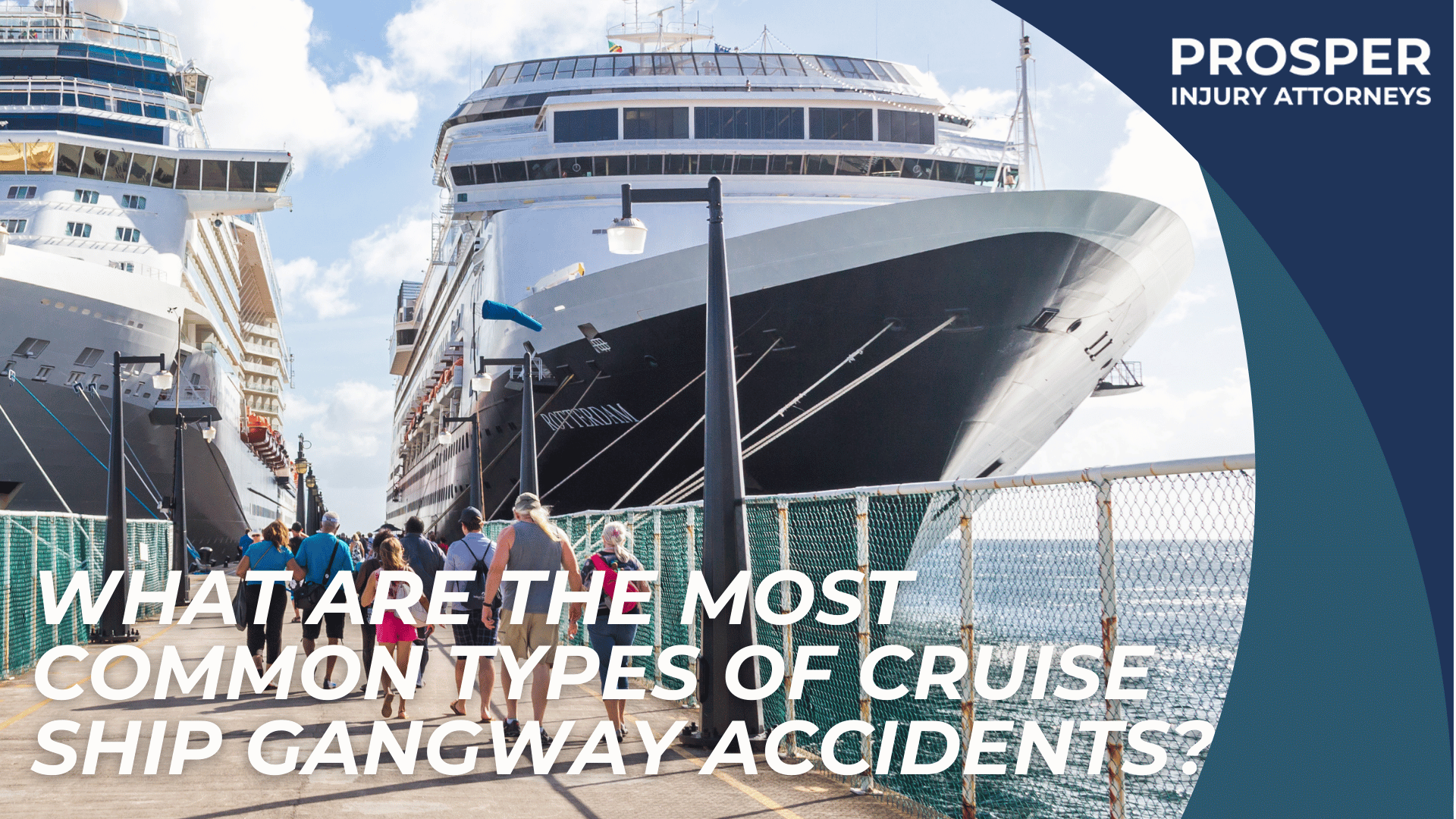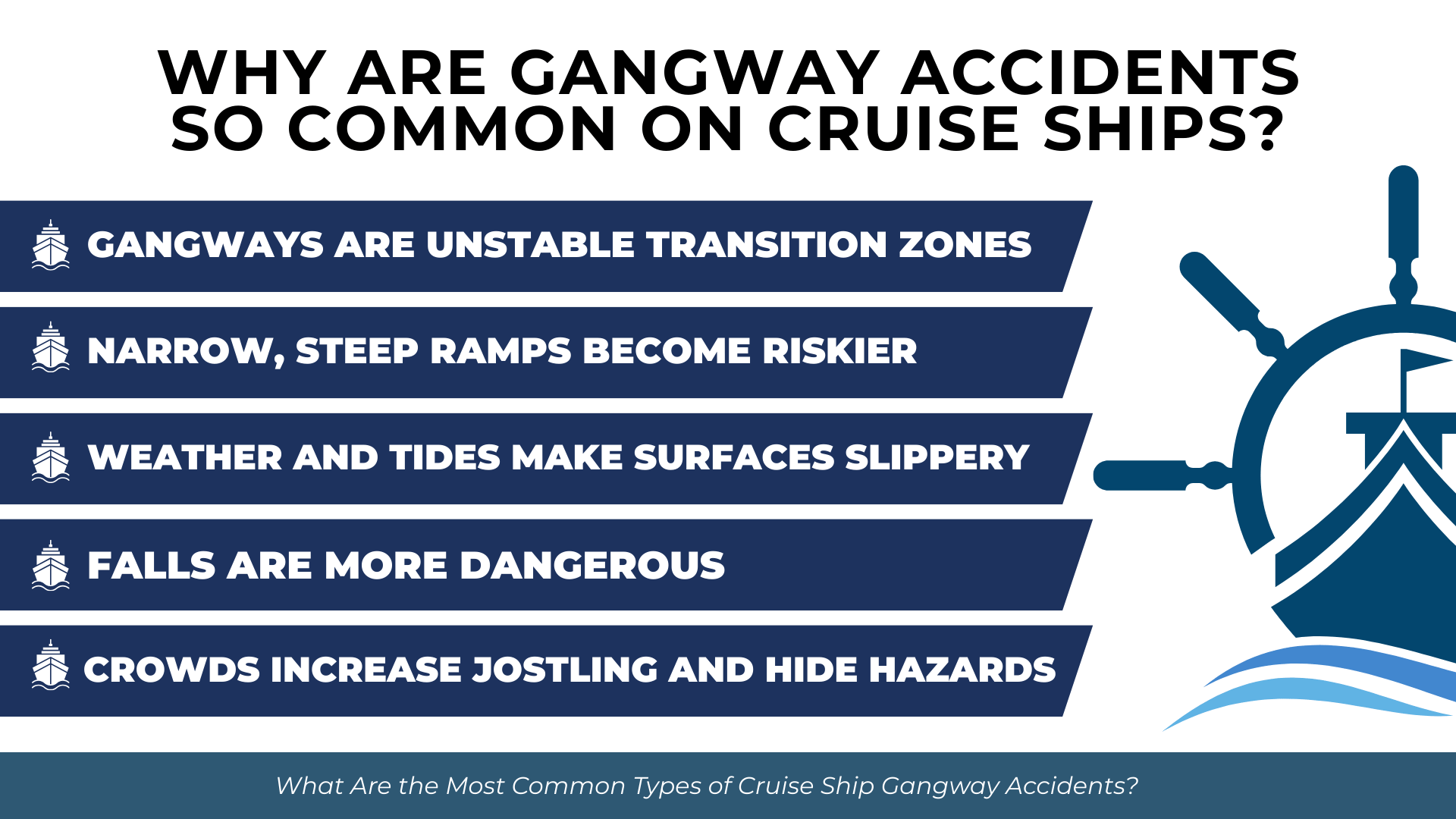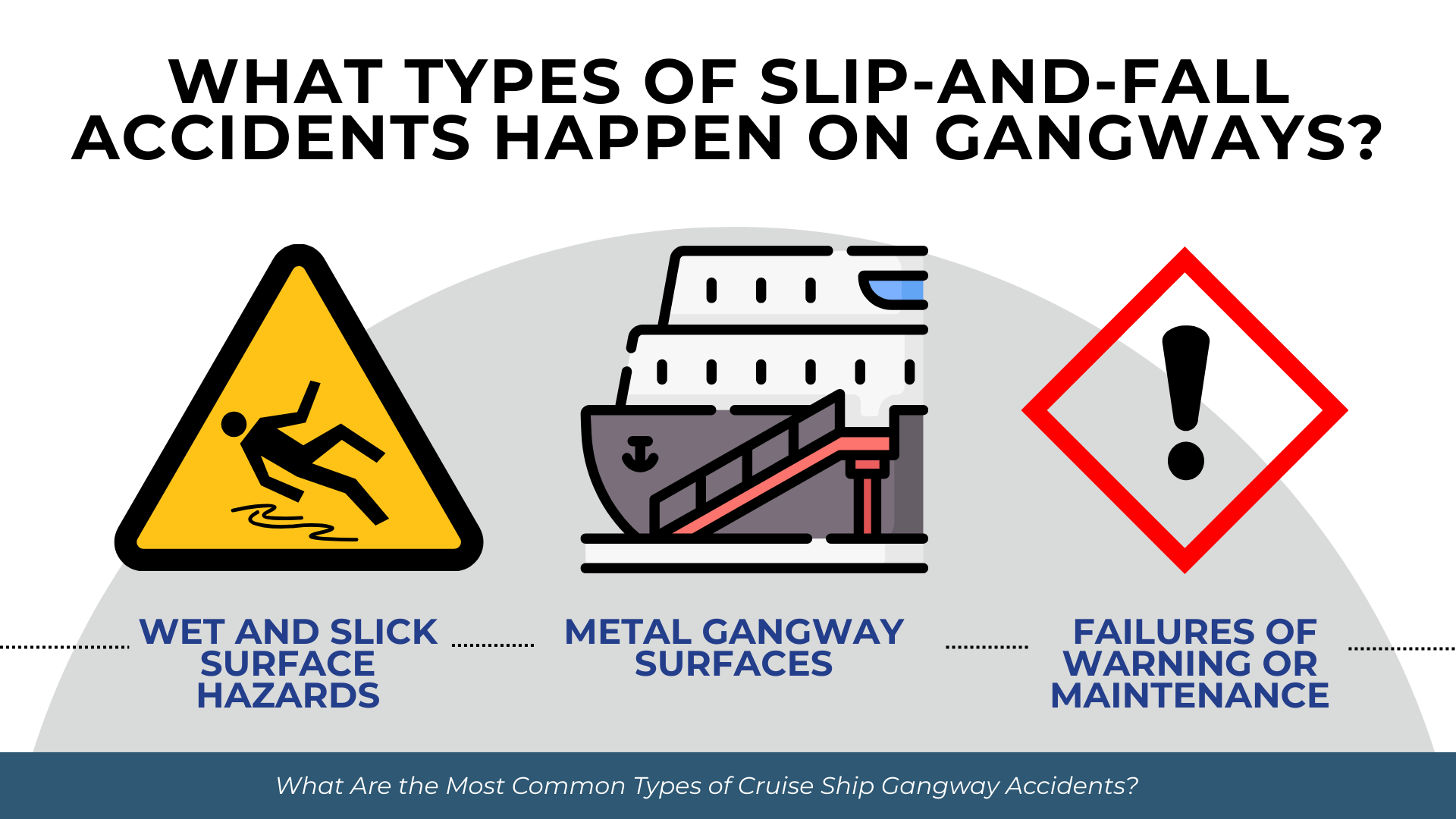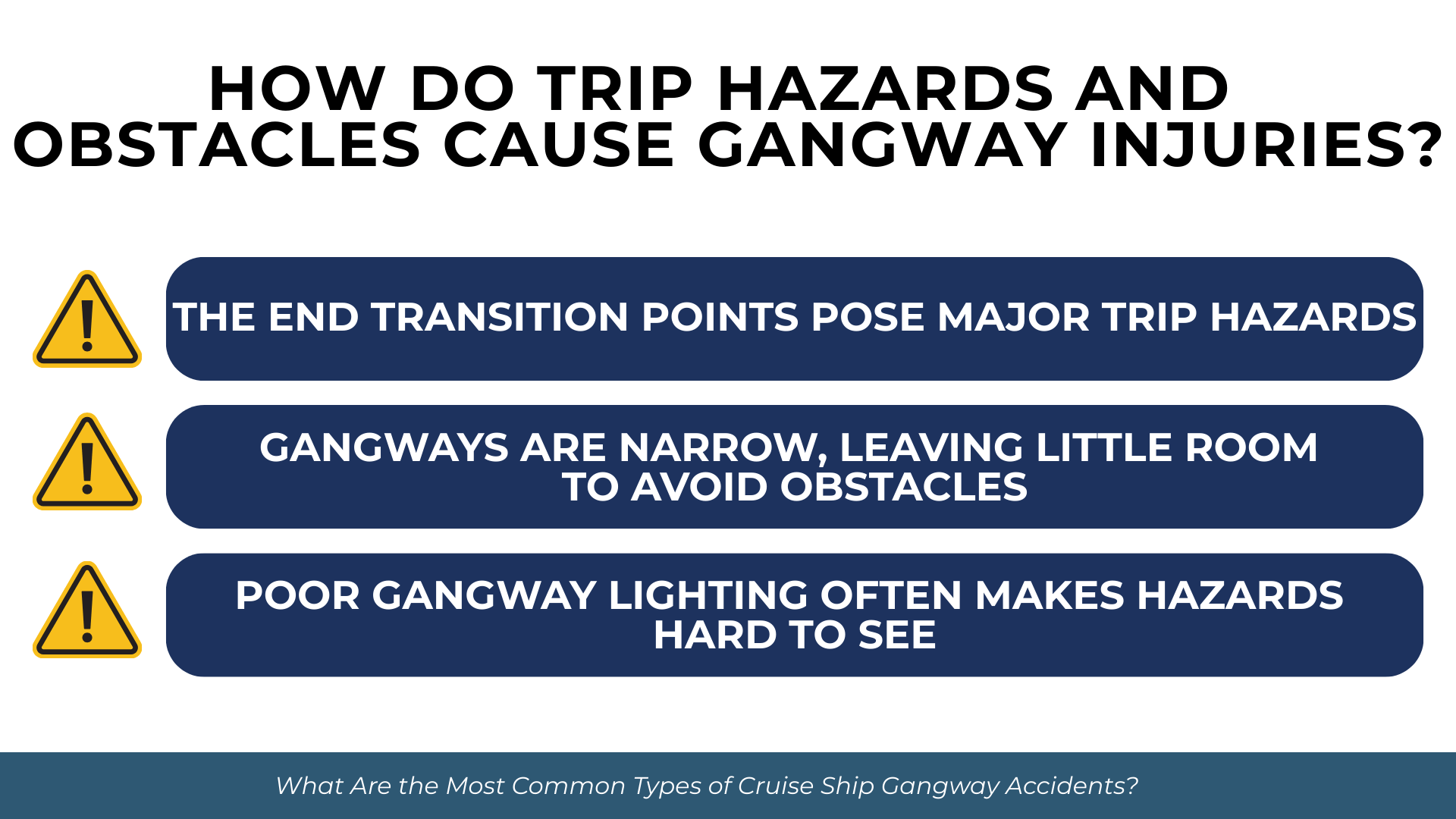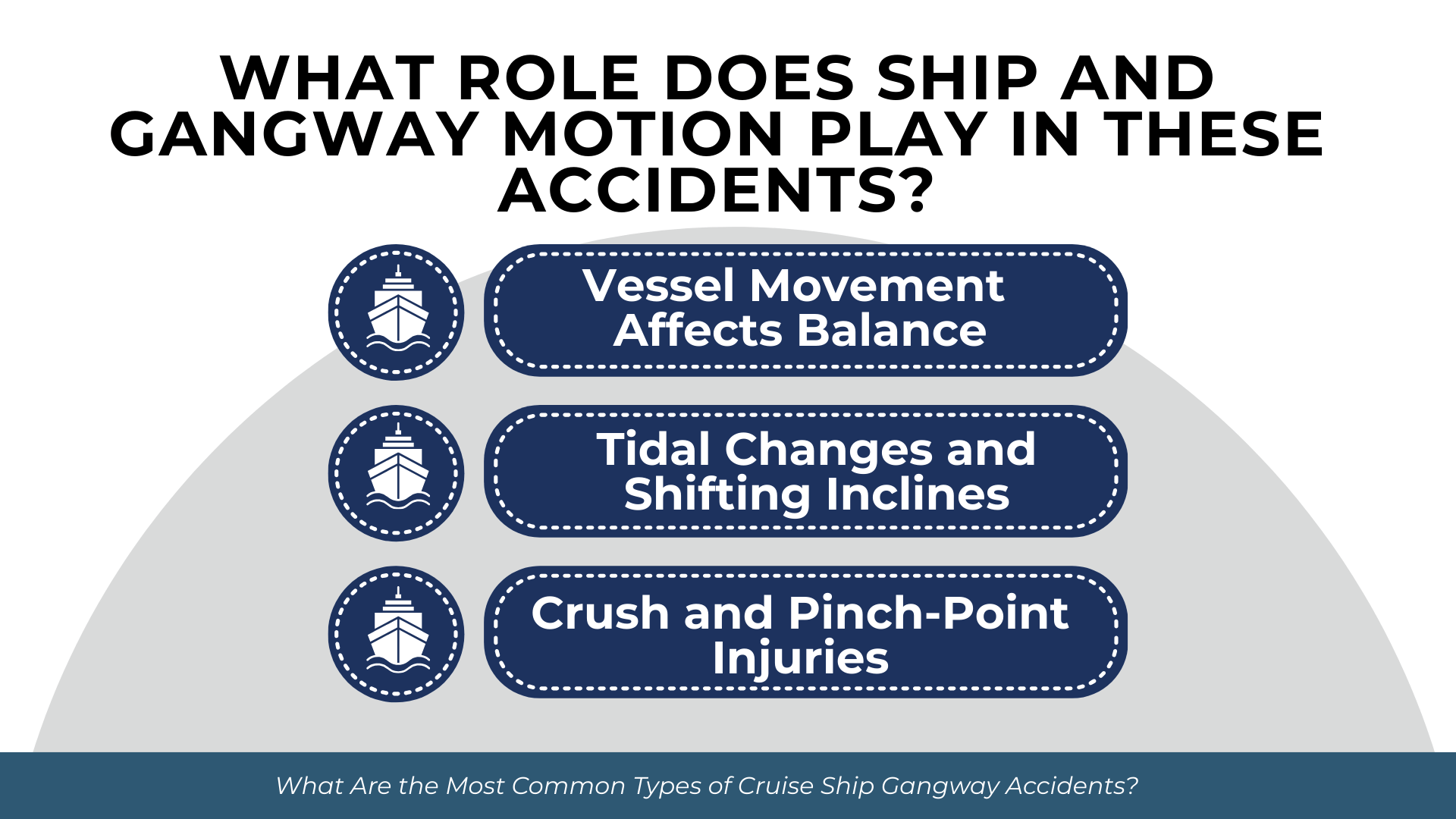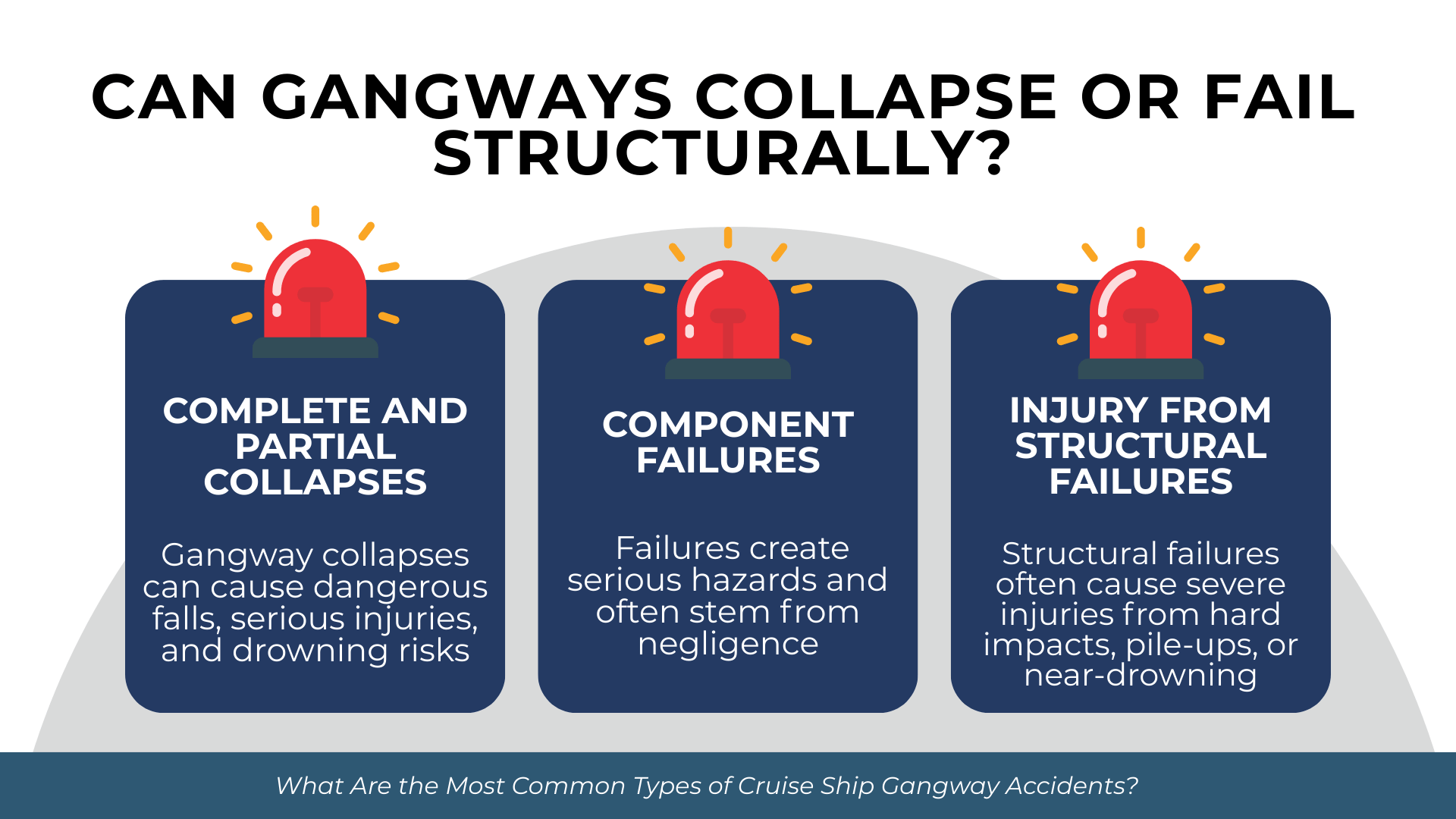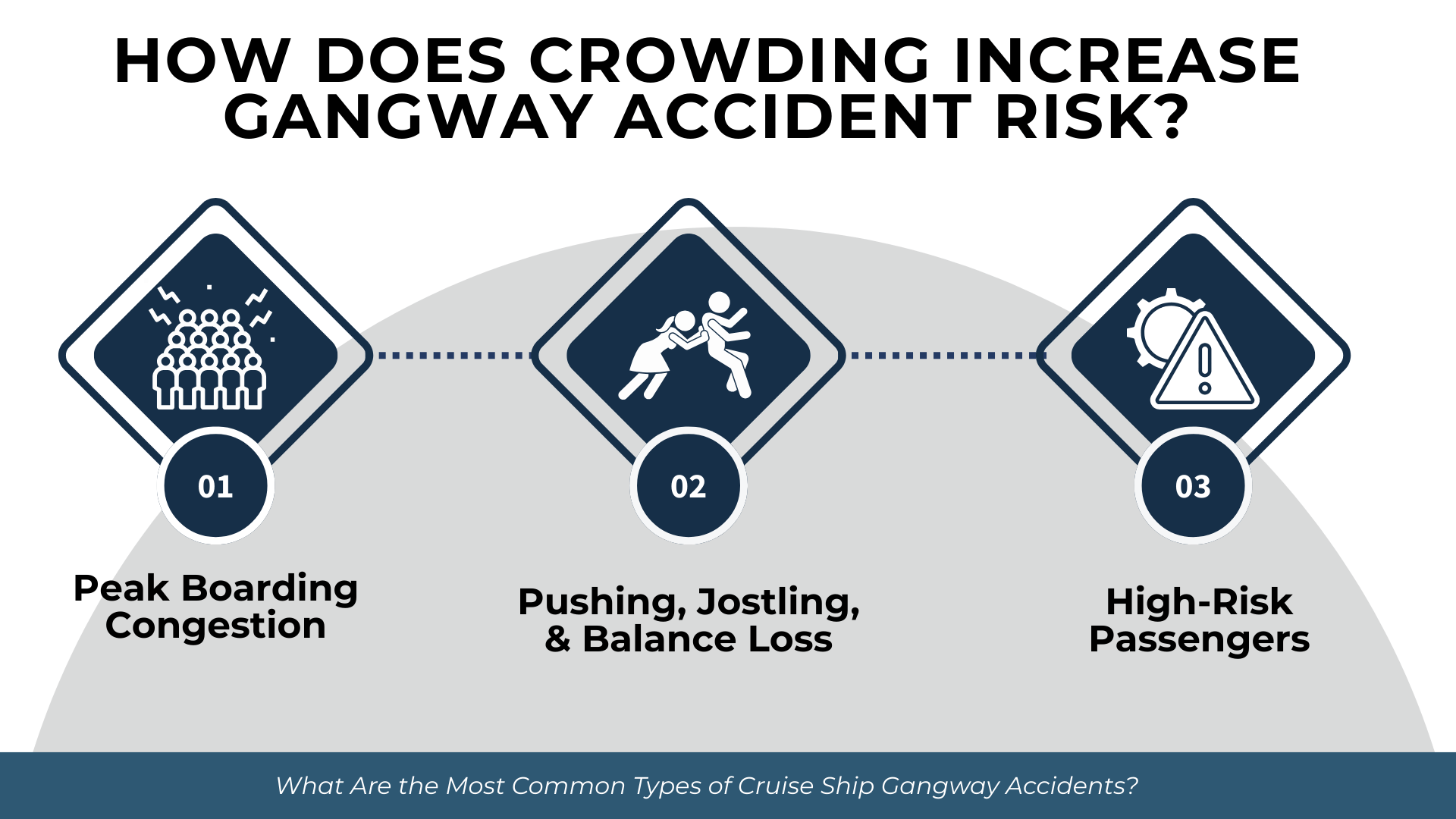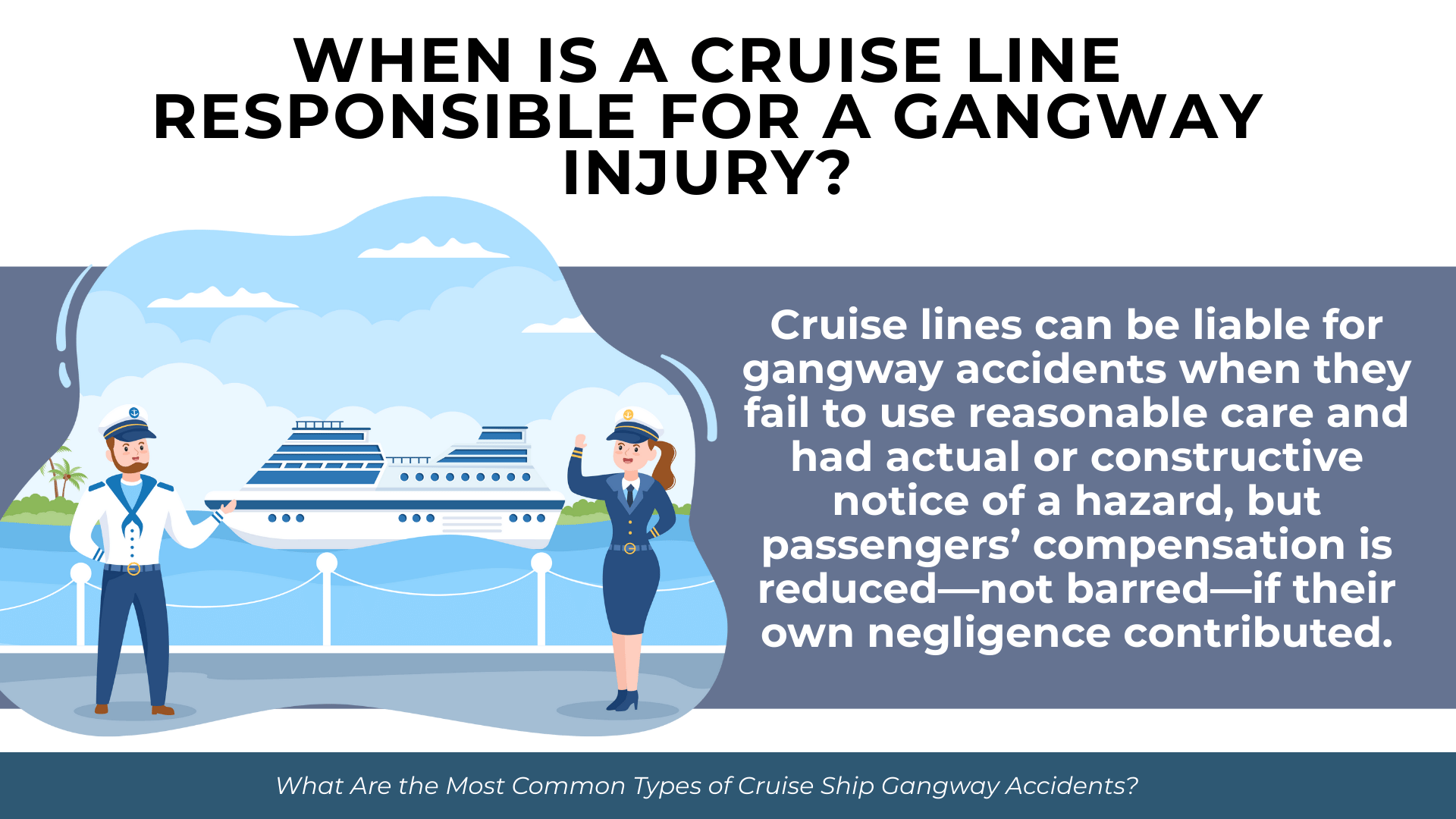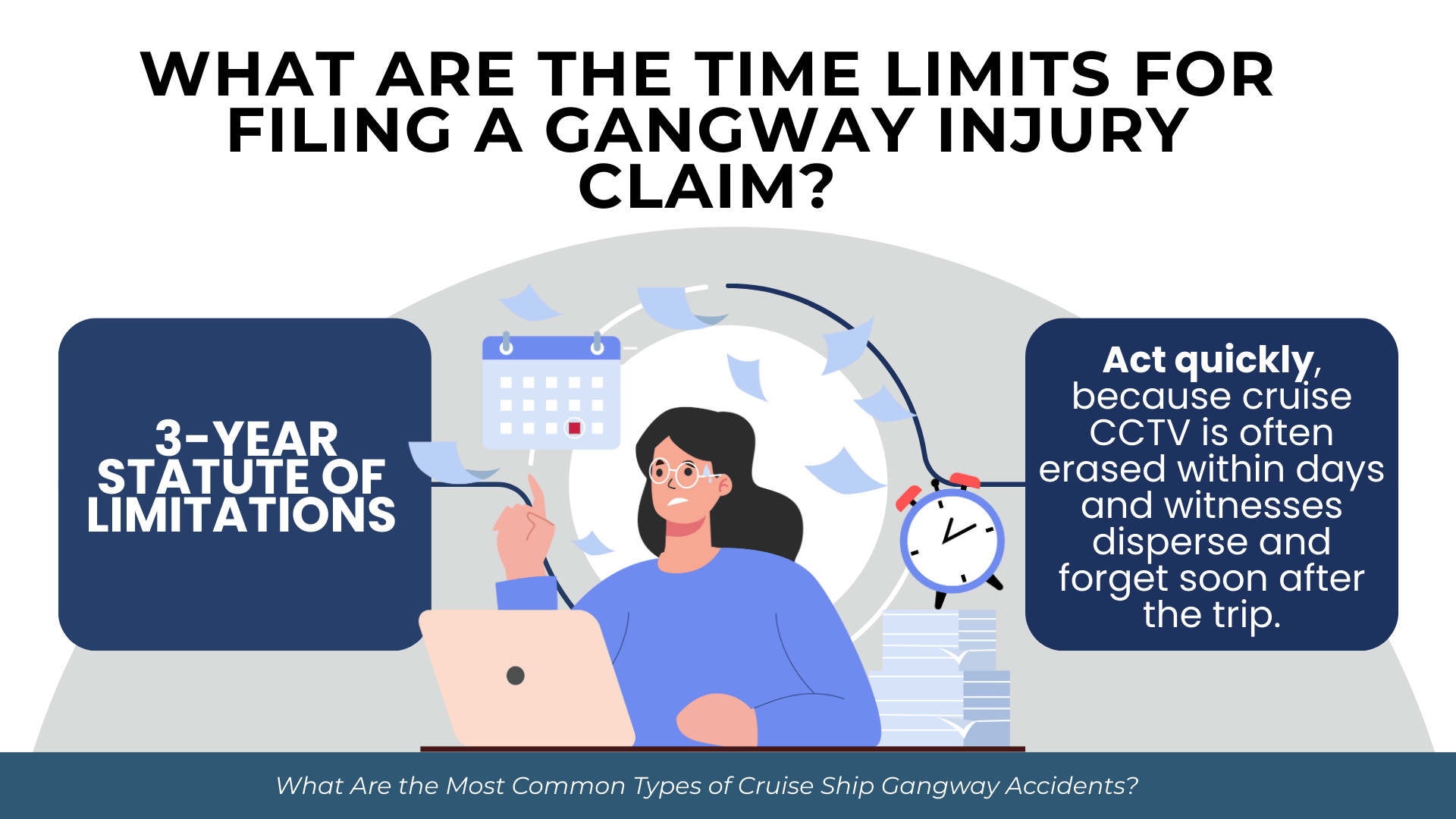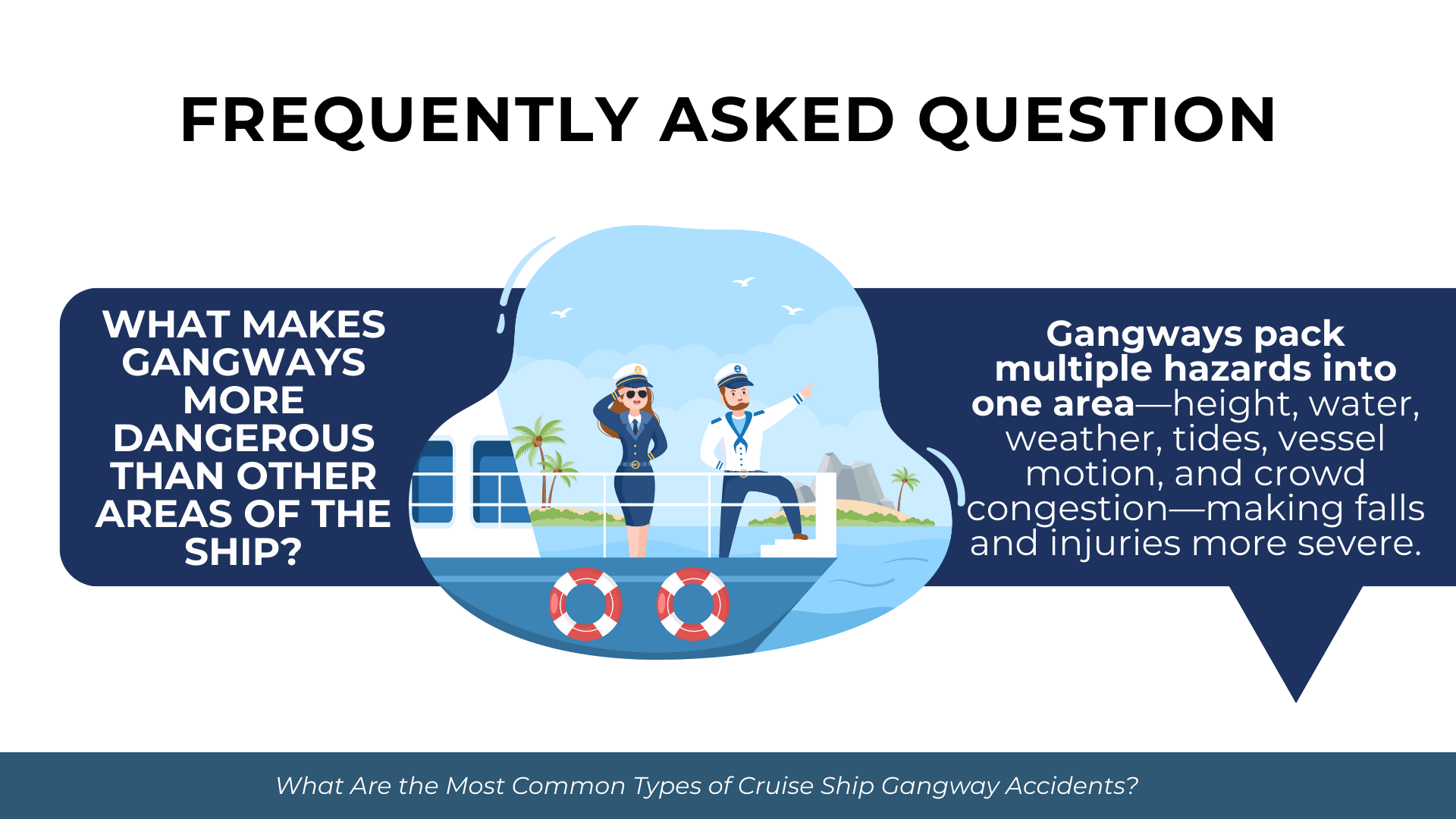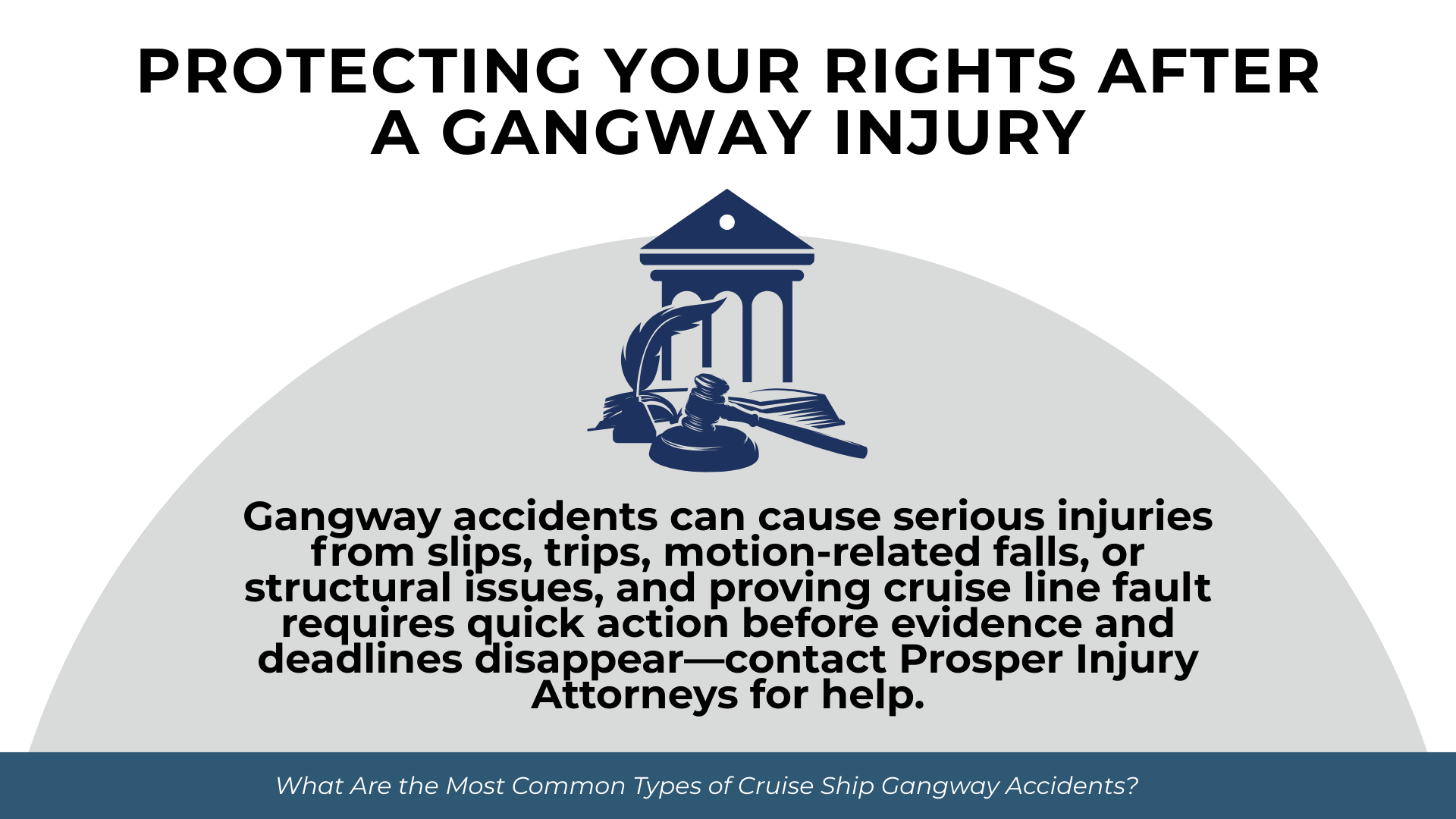Gangway accidents rank among the most dangerous incidents cruise passengers face. These boarding ramps—connecting the ship to the dock—create a concentrated zone of hazards that differs from anywhere else on the vessel. The height, incline, and over-water positioning of gangways means that even minor slips or stumbles can result in serious injuries.
If you were injured on a cruise ship gangway during boarding or disembarking, understanding how these accidents typically happen can help you recognize whether negligent conditions contributed to your injury. This guide examines the most common types of gangway accidents, the factors that cause them, and when cruise lines may be held responsible.
Why Are Gangway Accidents So Common on Cruise Ships?
Gangways present a unique combination of risks that passengers rarely encounter elsewhere during their cruise. Understanding why these boarding zones are so hazardous helps explain the frequency and severity of gangway injuries.
The unique risks of boarding zones
Gangways occupy a transitional space between the stable dock and the moving ship. Passengers must navigate a narrow, often steep ramp while carrying luggage, managing children, or using mobility devices. The gangway typically spans open water, meaning falls can result in multi-story drops rather than simple ground-level impacts.
Unlike the controlled interior of the ship, gangways are exposed to weather and constantly affected by the vessel’s movement. This combination of environmental exposure and physical transition creates conditions where accidents happen with troubling regularity.
Factors that increase gangway danger
Several conditions converge to make gangways especially hazardous. Weather plays a constant role—rain slicks metal surfaces, sea spray accumulates on handrails, and wind gusts can destabilize passengers mid-crossing. Tidal changes alter the gangway’s angle throughout the day, creating unexpected slopes that catch passengers off guard.
Crowding intensifies these risks. During embarkation and disembarkation, thousands of passengers funnel through a single access point. The resulting congestion creates jostling, reduces reaction time, and obscures hazards that might otherwise be visible.
Why these injuries are often serious
Gangway injuries frequently produce severe outcomes because of the mechanism of injury. Falls from height can cause fractures to the wrists, ankles, hips, and spine. Passengers caught between moving gangway sections or at connection points suffer crush injuries to hands and feet. In structural failure events, victims may sustain multi-system trauma or face near-drowning risks if they fall into the water below.
What Types of Slip-and-Fall Accidents Happen on Gangways?
Call us today at (305) 694-2676 or
contact us online for a free case evaluation.
Hablamos español.

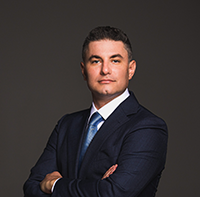
Slip-and-fall incidents represent the most frequent category of gangway accidents. The combination of metal surfaces, environmental moisture, and heavy foot traffic creates persistent slip hazards throughout boarding operations.
Wet and slick surface hazards
Gangway surfaces become dangerously slippery from multiple moisture sources. Unlike indoor ship areas where conditions can be controlled, gangways remain exposed to environmental factors that create slick patches unpredictably.
The following conditions commonly cause gangway slips:
- Rain and precipitation. Direct rainfall accumulates on metal gangway surfaces, overwhelming drainage capacity and creating standing water.
- Sea spray and condensation. Saltwater mist coats surfaces even in calm weather, while temperature differentials cause condensation on metal components.
- Spilled liquids. Beverages carried by boarding passengers, cleaning solutions, or hydraulic fluids from gangway mechanisms create isolated slick spots.
- Tracked water from the ship. Passengers exiting pool areas or wet decks carry moisture onto the gangway on their shoes and clothing.
- Inadequate drainage. Poorly designed or clogged drainage systems allow water to pool rather than flow away from walking surfaces.
Why metal gangway surfaces are particularly dangerous
Most gangways feature ridged metal surfaces designed to provide traction. However, these surfaces lose their grip significantly when wet. The ridges that normally prevent slipping can actually channel water beneath passengers’ feet, reducing contact with the non-slip surface.
Passengers wearing smooth-soled shoes, sandals, or flip-flops—common cruise attire—face elevated risk on wet metal. The tracked water from boarding passengers compounds the problem, as each person who crosses adds moisture to the surface.
Warning failures and inadequate treatment
Many gangway slip accidents involve failures of warning or maintenance. Crew may fail to place warning signs when conditions deteriorate, delay mopping or treatment of spilled liquids, or fail to close gangways during heavy rain. Passengers who cannot see or anticipate the hazard have little opportunity to protect themselves, particularly when crowd pressure prevents them from choosing their footing carefully.
How Do Trip Hazards and Obstacles Cause Gangway Injuries?
While slips involve loss of traction, trip accidents occur when passengers’ feet strike unexpected obstacles or surface changes. Gangways present numerous trip hazards that differ from those found elsewhere on the ship.
Thresholds and uneven surfaces
The transition points at each end of the gangway create significant trip risks. Raised thresholds, uneven flooring between the gangway and ship or dock, and loose carpeting at connection points catch passengers’ feet unexpectedly. Small steps or lips at these transitions can be difficult to perceive, especially when lighting is poor or passengers are focused on managing luggage.
The flooring materials themselves may create hazards. Carpet edges that curl or buckle, metal plates that shift underfoot, and height differentials between adjoining surfaces all contribute to trip incidents.
Obstacles in the walking path
The narrow configuration of most gangways leaves little room for error when obstacles appear in the walking path. Unsecured mats placed to absorb moisture can slide or bunch under foot traffic. Luggage congestion—particularly during embarkation when passengers carry maximum belongings—creates a gauntlet of trip hazards.
Passengers using wheelchairs, scooters, or walkers face particular challenges. The confined space makes maneuvering difficult, and small obstacles that able-bodied passengers might step over can completely block mobility device users.
Visibility and perception challenges
Lighting conditions on gangways vary dramatically. Passengers moving from bright terminal buildings to shaded gangways, or crossing during evening hours with inadequate artificial lighting, may fail to perceive surface changes until too late. Slope changes along the gangway’s length can be difficult to judge, and step-downs at connection points may blend into the surrounding surface when lighting is insufficient.
These perception challenges explain why many trip victims report that they “didn’t see” the hazard—not because it was hidden, but because lighting and visual conditions made it difficult to detect.
What Role Does Ship and Gangway Motion Play in These Accidents?
Motion-related accidents represent a distinct category of gangway injury. Unlike slips and trips that involve surface conditions, motion injuries result from dynamic forces that throw passengers off balance or create dangerous gaps and pinch points.
How vessel movement affects balance
Cruise ships move continuously, even when docked. Gentle pitch and roll from harbor currents, passing vessels, or loading operations transmitted through the gangway to passengers crossing it. These movements are subtle but sufficient to disrupt balance, particularly for passengers unfamiliar with compensating for ship motion.
Passengers are routinely reminded to use handrails throughout the ship because motion is an underlying factor in many injury mechanisms. This advice applies doubly on gangways, where the narrow walkway and elevated position leave little margin for recovery if balance is lost.
Tidal changes and shifting inclines
Gangway angle changes throughout the day as tides rise and fall. A gangway that slopes gently downward during boarding may tilt steeply upward by the time passengers disembark hours later. These angle changes catch passengers off guard, creating unexpected slopes that alter gait and increase fall risk.
Motion-related hazards from gangway movement include:
- Tidal angle changes. Rising and falling tides alter gangway slope by significant degrees over the course of hours.
- Tender misalignment. When passengers board from tender boats rather than fixed docks, wave action causes constant relative movement.
- Sudden lifts and drops. Improper securing allows gangway sections to rise and fall abruptly as the ship moves.
- Lateral shifts. Side-to-side movement of unsecured gangways creates balance challenges beyond normal fore-aft motion.
- Improper securing. Failures to properly attach and stabilize gangways allow unpredictable movement patterns.
Crush and pinch-point injuries
Motion creates dangerous gaps between gangway sections and between the gangway and ship or dock. These gaps open and close as the vessel moves, creating pinch points that can trap hands, feet, or limbs. “Lift-and-slam” events occur when gangway sections separate and then come together forcefully, causing crush injuries to passengers caught in the gap.
These injuries often affect passengers who reach for handrails near connection points or who step at the precise moment a gap opens. The resulting crush injuries can be severe, involving fractures, amputations, or permanent damage to extremities.
Can Gangways Collapse or Fail Structurally?
Get started with your complimentary case evaluation today;
call us at (305) 694-2676 or reach us online using our
secure contact form.


Structural failures represent the most catastrophic category of gangway accidents. While less common than slips, trips, or motion injuries, gangway collapses produce the most severe outcomes and strongest liability cases.
Complete and partial collapses
Gangway collapses occur when structural components fail under load. Contributing factors include poor maintenance that allows corrosion or fatigue to weaken supports, overloading when too many passengers occupy the gangway simultaneously, improper deployment that stresses components beyond design limits, and failure to monitor passenger counts during peak boarding.
Complete collapses can drop passengers to the pier below or into the water, resulting in multi-trauma injuries, drowning risks, and occasionally fatalities. Partial collapses—where one section fails while others hold—create chaotic pile-up situations as passengers fall into each other.
Component failures
Even without full collapse, individual component failures create serious hazards. Handrail failures remove the primary safety device passengers rely on for stability. Support pin failures cause sudden sagging or tilting that throws passengers off balance. Attachment point failures at the ship or dock end create gaps or drops at the most critical transition zones.
These component failures are often framed legally as negligent inspection or maintenance rather than unforeseeable accidents. Unlike a sudden spill that appears without warning, structural deterioration develops over time and should be detected through proper inspection protocols.
Injury patterns from structural failures
Structural failure injuries tend to be severe. Falling passengers strike hard surfaces—metal decking, concrete piers, or water from significant height. Pile-up situations cause secondary injuries as passengers land on each other or are struck by falling luggage. Near-drowning becomes a risk when passengers fall into harbor water, particularly if injuries prevent them from swimming or if they become trapped beneath the failed structure.
How Does Crowding Increase Gangway Accident Risk?
Crowd-related accidents often combine with other hazard types—a passenger pushed off balance is more likely to slip on a wet surface or trip over an obstacle. Understanding how crowding amplifies gangway dangers explains why so many accidents occur during peak boarding periods.
Peak boarding congestion
Modern cruise ships carry between 3,000 and 6,000 passengers, and all must board and disembark through limited access points. Peak congestion occurs during initial embarkation, final disembarkation, and port-day boarding when passengers return from shore excursions. These surges create bottlenecks at gangways that force passengers into close contact and restrict individual movement.
Crew are typically stationed at bottlenecks to direct flow and encourage use of alternative routes, but passenger volume during peak periods often overwhelms management efforts.
Pushing, jostling, and balance loss
Crowded conditions create physical forces that passengers cannot fully control. The following factors contribute to crowd-related gangway accidents:
- Pushing and jostling. Passengers pressed together transfer forces through the crowd, destabilizing those near the edges or on sloped sections.
- Inadequate spacing. When passengers cannot maintain safe distances, the stumble of one person triggers chain-reaction falls.
- Lack of crew supervision. Insufficient staffing at gangways allows dangerous crowding to develop unchecked.
- Luggage interference. Bags, strollers, and carry-ons reduce maneuverability and create obstacles within the moving crowd.
- Passenger haste. Eagerness to board or concerns about missing departure create rushing behavior that increases collision risk.
High-risk passengers
Certain passengers face elevated risk in crowded gangway conditions. Elderly passengers with balance limitations cannot compensate quickly for unexpected jostling. Wheelchair and scooter users find their mobility devices difficult to control on inclines when surrounded by moving pedestrians. Passengers managing young children have divided attention and limited ability to protect themselves.
When cruise lines fail to provide adequate assistance for high-risk passengers—such as priority boarding, crew escorts, or accessible alternatives—liability exposure increases significantly.
When Is a Cruise Line Responsible for a Gangway Injury?
Understanding when cruise lines bear legal responsibility for gangway accidents requires examining the maritime legal standards that apply to passenger injuries. These standards differ from ordinary land-based premises liability in important ways.
The duty of reasonable care
Under maritime law, the gangway is considered part of the vessel. This means cruise lines owe passengers a duty of reasonable care in the gangway’s design, maintenance, setup, supervision, and crowd control. The foundational case establishing this standard is Kermarec v. Compagnie Générale Transatlantique, 358 U.S. 625 (1959), which held that vessel owners owe a duty of reasonable care to anyone legitimately aboard.
This duty is not strict liability—cruise lines are not automatically responsible for every gangway injury. However, when negligent conditions contribute to an accident, and the cruise line created those conditions or knew about them, liability may attach.
Proving the cruise line had notice
A cruise line is liable only if it had actual or constructive notice of the dangerous condition. This standard comes from Keefe v. Bahama Cruise Line, 867 F.2d 1318 (11th Cir. 1989). Actual notice exists when the cruise line created the hazard or had direct knowledge of it. Constructive notice exists when prior similar incidents occurred or the hazard existed long enough that reasonable inspection would have discovered it.
Evidence establishing notice includes CCTV footage showing when a hazard developed, maintenance logs documenting known problems, prior incident reports involving similar conditions, and inspection records showing what crew knew or should have discovered.
How passenger fault affects recovery
Maritime law uses pure comparative negligence, established in United States v. Reliable Transfer Co., 421 U.S. 397 (1975). If a passenger’s own conduct contributed to the accident—such as running on the gangway, ignoring warning signs, or wearing inappropriate footwear—damages are reduced by the passenger’s percentage of fault but never completely barred.
This means even passengers who were partially responsible for their accidents may still recover compensation. A passenger found 30% at fault would receive 70% of their total damages rather than nothing.
What Are the Time Limits for Filing a Gangway Injury Claim?
Time limits for cruise ship injury claims are shorter than most passengers expect. Missing these deadlines can permanently bar recovery regardless of how strong the underlying case might be.
Statutory and contractual deadlines
Federal maritime law establishes a three-year statute of limitations for maritime torts under 46 U.S.C. § 30106. However, cruise ticket contracts routinely shorten this period. Most major cruise lines require lawsuits to be filed within one year of the incident and impose separate notice requirements—often requiring written notice within six months—as a precondition to suit.
These contractual limitations are generally enforceable under Carnival Cruise Lines, Inc. v. Shute, 499 U.S. 585 (1991). Passengers who fail to comply with notice deadlines may find their claims barred even within the one-year suit limitation.
Why acting quickly matters
Beyond formal deadlines, practical considerations favor prompt action. Cruise ships maintain CCTV systems that cover many public areas including gangways, but footage is typically overwritten within 7 to 30 days unless a litigation hold is requested. Witnesses disperse after the cruise ends, and memories fade quickly.
Evidence that could establish how long a hazard existed, whether crew were aware of it, and exactly how the accident occurred may be lost if preservation efforts do not begin immediately.
Frequently Asked Questions
What makes gangways more dangerous than other areas of the ship?
Gangways combine multiple hazards in a concentrated space. They span open water at height, meaning falls produce more serious injuries than ground-level accidents. They’re exposed to weather conditions that create slippery surfaces, affected by tidal changes that alter their slope throughout the day, and subject to vessel motion that disrupts passenger balance. The narrow configuration also forces thousands of passengers through a single access point during peak boarding periods.
What types of conditions cause the most gangway slip accidents?
Wet and slick surfaces account for most gangway slips. Rain and sea spray accumulate on metal surfaces, spilled liquids create isolated slick spots, and passengers tracking water from pool areas add moisture with each crossing. The ridged metal surfaces designed to provide traction actually lose their grip significantly when wet, particularly for passengers wearing smooth-soled shoes, sandals, or flip-flops.
How does ship motion contribute to gangway accidents?
Even when docked, cruise ships move continuously from harbor currents, passing vessels, and loading operations. This motion transmits through the gangway and disrupts passenger balance. More significantly, tidal changes alter the gangway’s angle throughout the day—a gently sloping ramp during morning boarding may tilt steeply by afternoon disembarkation. Ship movement also creates dangerous gaps between gangway sections that open and close unpredictably, causing crush injuries to hands and feet.
What causes gangway structural failures?
Structural failures result from poor maintenance allowing corrosion or fatigue, overloading when too many passengers occupy the gangway simultaneously, improper deployment that stresses components beyond design limits, and failure to monitor passenger counts. Even without full collapse, individual component failures—such as handrails, support pins, or attachment points—can cause sudden sagging or tilting that throws passengers off balance or creates dangerous gaps.
Who faces the highest risk for gangway injuries?
Elderly passengers with balance limitations cannot compensate quickly for unexpected jostling or surface changes. Wheelchair and scooter users find their mobility devices difficult to control on inclines, especially when surrounded by moving crowds. Passengers managing young children have divided attention and reduced ability to steady themselves. Passengers carrying heavy luggage, strollers, or personal items also face elevated risk because their hands are occupied and their center of gravity is affected.
What kinds of injuries typically result from gangway accidents?
Gangway accidents commonly produce wrist, ankle, hip, and spinal fractures from falls on hard surfaces. Head trauma occurs when passengers strike metal decking or concrete piers. Ligament and soft-tissue injuries result from twisting falls or attempts to catch oneself. Crush injuries to hands and feet happen when extremities are caught between moving gangway sections or at connection points. In structural failure events, victims may suffer multi-system trauma or face near-drowning risks if they fall into the water.
Protecting Your Rights After a Gangway Injury
Gangway accidents produce serious injuries through predictable mechanisms—slips on wet surfaces, trips over obstacles, motion-related falls, structural failures, and crowd-related incidents. While cruise lines have a duty to maintain safe boarding conditions, establishing their responsibility requires understanding what happened, proving they knew or should have known about the hazard, and acting within strict time limits.
If you or a family member suffered an injury on a cruise ship gangway, the evidence needed to support your claim may be disappearing. CCTV footage overwrites, witnesses scatter, and contractual deadlines approach faster than most passengers realize.
Contact Prosper Injury Attorneys to discuss your gangway injury case.

